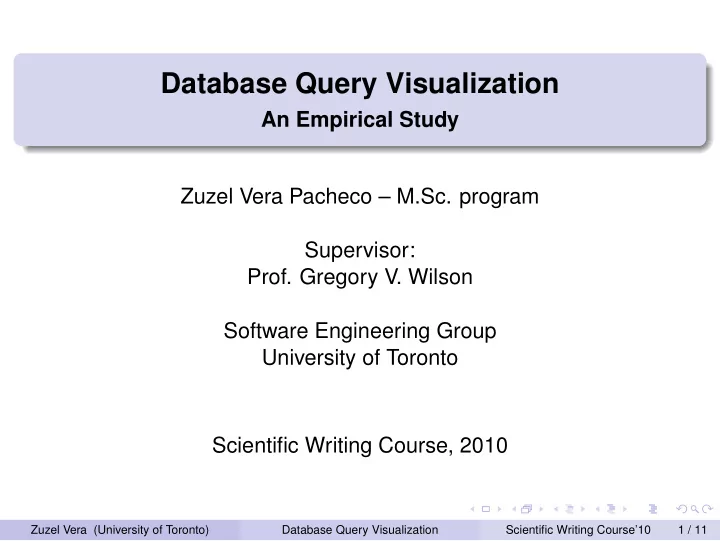

Database Query Visualization An Empirical Study Zuzel Vera Pacheco – M.Sc. program Supervisor: Prof. Gregory V. Wilson Software Engineering Group University of Toronto Scientific Writing Course, 2010 Zuzel Vera (University of Toronto) Database Query Visualization Scientific Writing Course’10 1 / 11
Natural Language Get the number of wins and the names of all the teams who scored a goal at the 2010 World Cup. Arrange the results in descending order based on the number of wins. Structured Query Language (SQL) SELECT team, wins FROM world_cups WHERE year = 2010 AND goals > 0 ORDER BY wins DESC; Query By Example (QBE) year team minutes_played goals wins 2010 P . > 0 P .DO What is the best type of representation for a particular task? Zuzel Vera (University of Toronto) Database Query Visualization Scientific Writing Course’10 2 / 11
Design of a Diagrammatic Notation Programmers use of ad hoc notations instead of standard notations (Cherubini et al., 2007) This project: designed and executed an empirical study to determine the common features of ad hoc notations Zuzel Vera (University of Toronto) Database Query Visualization Scientific Writing Course’10 3 / 11
Table-based Notations Zuzel Vera (University of Toronto) Database Query Visualization Scientific Writing Course’10 4 / 11
Order-based Notations Zuzel Vera (University of Toronto) Database Query Visualization Scientific Writing Course’10 5 / 11
Artificial Data Examples Zuzel Vera (University of Toronto) Database Query Visualization Scientific Writing Course’10 6 / 11
Natural Language Descriptions Zuzel Vera (University of Toronto) Database Query Visualization Scientific Writing Course’10 7 / 11
Notational Characteristics Participants Percentages (between subjects) Yes No Yes No Table-based notation 19 11 63% 37% Order-oriented notation 10 20 33% 67% Natural language descriptions 5 25 17% 83% Artificial data examples 8 22 27% 73% Preliminary Results Zuzel Vera (University of Toronto) Database Query Visualization Scientific Writing Course’10 8 / 11
Work in Progress Code the data and analyze the order in which the diagrams were drawn Differentiate common vs. casual characteristics of the notations Future Work Propose alternative notations for the representation of database queries Design studies comparing the proposed notations and SQL Develop and evaluate a query visualization tool Zuzel Vera (University of Toronto) Database Query Visualization Scientific Writing Course’10 9 / 11
Summary We want to know what notation should be used to represent database queries. After conducting a study involving 30 participants, we are working on the analysis of the data Future work includes the development and evaluation of a query visualization tool. Zuzel Vera (University of Toronto) Database Query Visualization Scientific Writing Course’10 10 / 11
Thanks! Contact Information zuzelvp@cs.toronto.edu http://zuzelvp47uoft.wordpress.com Bahen Centre, room 3228 Zuzel Vera (University of Toronto) Database Query Visualization Scientific Writing Course’10 11 / 11
Recommend
More recommend